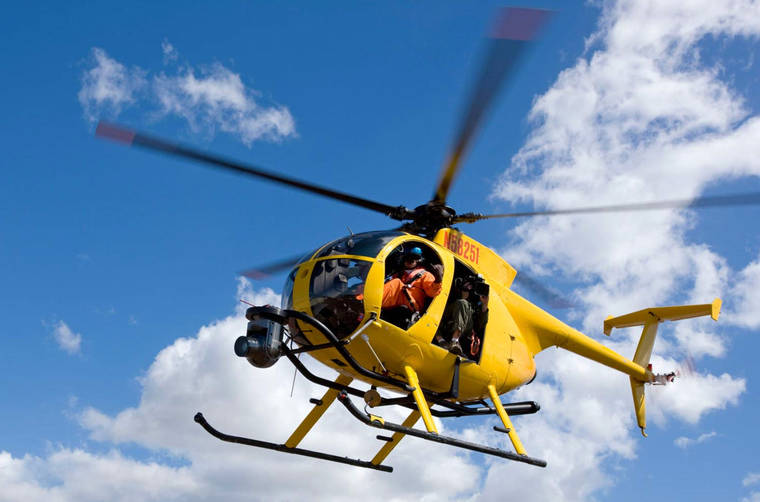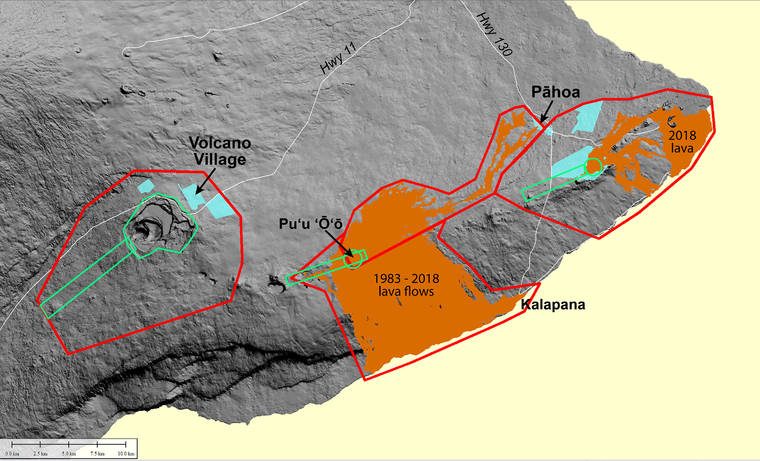HAWAII VOLCANOES NATIONAL PARK — Since the end of 2018’s volcanic activity, USGS Hawaiian Volcano Observatory scientists have wanted to resurvey Kilauea Volcano’s ground surface to document changes brought about by the Puna eruption and summit collapse. Doing so would allow us to more accurately answer questions about the total volumes of erupted lava and summit subsidence that occurred last summer.
By detailing these changes, it could also facilitate recovery and long-term risk mitigation projects by local partner agencies. A new survey would also allow comparison to earlier digital elevation data sets acquired by both helicopter lidar (light detection and ranging) and by UAS (unmanned aerial systems) imagery during Kilauea’s 2018 eruption.
We are happy to announce that our desire to resurvey Kilauea will soon become a reality. The precision of this new survey will improve the accuracy of those earlier data sets.
The data will be acquired by a bright yellow helicopter flying over much of Kilauea’s summit and East Rift Zone at an altitude of 1,300 feet above ground level. The aircraft will fly in a lawn-mowing pattern, back and forth in a northeast-southwest direction. A few smaller areas on Kilauea, namely parts of the East Rift Zone (Leilani Estates, Ala Ili Road, and Puu Oo), the upper Southwest Rift Zone, and the summit caldera, will be flown at a lower altitude of 500 feet.
These helicopter flights are currently planned for the period of June 13 to June 30, weather permitting.
The survey will use lidar technology capable of sending out hundreds of laser pulses per second. This should allow coverage of at least 30 laser pulses per square meter (ppsm), or about 3 pulses per square foot. The lower elevation flights will allow coverage of at least 100 ppsm, or about 9 pulses per square foot.
Why collect the lidar with such high-resolution? It’s the best way to detect and map vertical or near-vertical features, and there are a lot of them — from ground cracks everywhere, to fissures in the lower East Rift Zone (LERZ) and caldera walls at Kilauea’s summit. High-resolution lidar is the best way to document and measure these potentially hazardous features.
A helicopter, rather than a fixed-wing aircraft, will be used for the survey because it can fly slower and acquire high-resolution lidar. The helicopter can also work even if there is high-altitude cloud cover.
The new lidar surface from this survey can be used to model where new lava flows may travel if renewed volcanic activity occurs in the LERZ. From an emergency management perspective, having these models was important during Kilauea eruption responses in 2014-2015 and 2018.
The bare-earth elevation model (digitally stripped of all vegetation) is the main interest of geologists because it will reveal geologic features such as faults and cracks that are not yet mapped. However, the lidar point cloud data from which it is derived will also contain other data, such as vegetation type and density. This could be a goldmine for biologists mapping flora on Kilauea.
To illustrate the power of lidar, in a USGS 8 ppsm lidar survey of Glacier Peak volcano in Washington, it is possible to differentiate between maple, alder, and fir trees in the vegetation points. Blackberries at the edges of open areas can also be detected. In California, lidar surveys are used to catalog vegetation that could fuel forest fires.
Along with lidar data, the helicopter will simultaneously collect 4-band digital imagery (red-green-blue, or RGB, plus near-infrared). These multispectral images will also be useful to help detect geologic features and classify vegetation.
The final products of this survey, a digital elevation model and detailed imagery covering surveyed areas, will be made public and should be available by late 2019.
We understand that helicopter noise can be disruptive, so we will greatly appreciate affected residents’ patience and understanding as we collect this extremely important data to help mitigate future lava flow hazards. The survey should take only 8-10 days, weather permitting, to complete.
Volcano Activity Updates
Kilauea Volcano is not erupting and its USGS Volcano Alert level remains at normal. For definitions of USGS Volcano Alert Levels, see https://volcanoes.usgs.gov/vhp/about_alerts.html.
Rates of deformation, gas release, and seismicity on Kilauea have not changed significantly over the past week.
Since early March, GPS stations and tiltmeters at Kilauea’s summit have recorded deformation consistent with slow magma accumulation within the shallow portion of the summit magma system. However, gas measurements have not indicated shallowing of large volumes of magma.
On Kilauea’s East Rift Zone, GPS stations and tiltmeters continue to show motions consistent with refilling of the deep magmatic reservoir in the broad region between Puu Oo and Highway 130. This trend has been observed since the end of the 2018 eruption, although there is an indication that this motion has been slowing down over the past couple weeks.
Sulfur dioxide emission rates on Kilauea’s ERZ and summit remain low, but HVO continues to closely monitor gas emissions in both areas for any changes.
Two earthquakes with three or more felt reports occurred in the Hawaiian Islands this past week: a magnitude-2.8 quake 4 miles southeast of Waimea at 11 7 miles depth on May 25 at 10:35 p.m. HST, and a magnitude-3.4 quake 9 miles northeast of Waialua at 16 miles depth on May 24 at 3:16 a.m. HST.
Hazards remain at the lower ERZ and summit of Kilauea. Residents and visitors near the 2018 fissures, lava flows, and summit collapse area should heed Hawaii County Civil Defense and Hawaii Volcanoes National Park closures and warnings. Hawaii County Civil Defense advises that lava flows from the 2018 eruption are primarily on private property; people are asked to be respectful and to not enter or park on private property.
The USGS Volcano Alert level for Mauna Loa remains at normal.
HVO continues to closely monitor both Kilauea and Mauna Loa for any signs of increased activity.
Please visit HVO’s website (https://volcanoes.usgs.gov/hvo) for past Volcano Watch articles, Kilauea and Mauna Loa updates, volcano photos, maps, recent earthquake info, and more. Call 967-8862 for weekly Kilauea updates. Email questions to askHVO@usgs.gov.
Volcano Watch is a weekly article and activity update written by U.S. Geological Survey Hawaiian Volcano Observatory scientists and affiliates.


